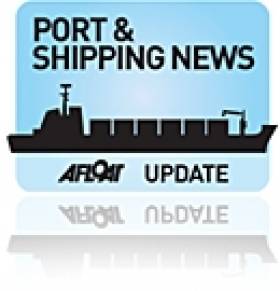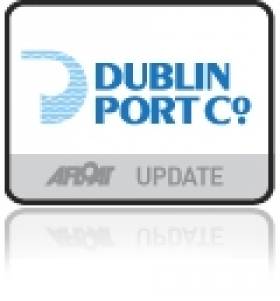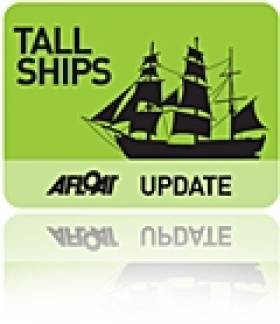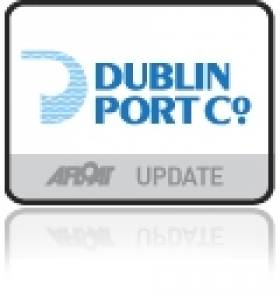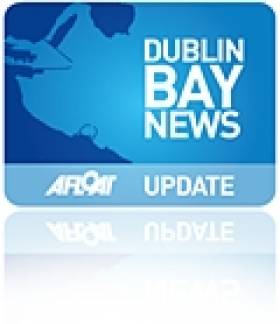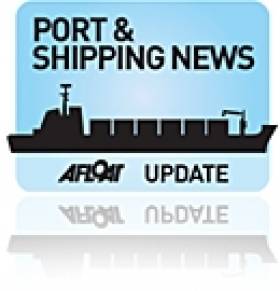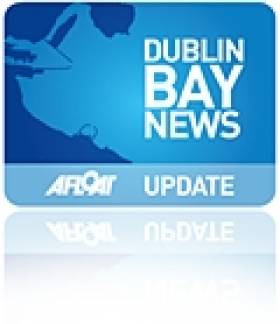Displaying items by tag: Dublin Port Company
Expansion Is The Only Way Says Dublin Port Chief
Trade at Dublin Port is set to more than double over the next 30 years, according to its chief executive Eamonn O'Reilly.
In an interview with The Irish Times last week, O'Reilly elaborated on the new 'master plan' for the port, which is based on an estimated trade growth to 60 million tonnes (or 2.5% annually) by 2040.
“Last year’s growth [of 6.1%] suggests to me that we need to get our planning caps on and get a solid and robust master plan in place,” said O’Reilly.
The master plan, according to the Dubin Port chief, will require expansion of the existing port by reclaiming up to 40 hectares, as well as a greater integration with bordering areas.
Previous attempts to expand have faced much opposition from conservation groups and local residents for a number of years.
O’Reilly stressed that the local community will be engaged on the issues involved before Dublin Port produces a final proposal at the end of the year.
But he also insisted that "there’s no project [that hee knows of] for port expansion that doesn’t involve reclamation", despite proposals to establish a new port at Bremore.
Read more of the Irish Times interview with Eamonn O'Reilly HERE.
Masterplan for Development of Dublin Port Announced
A public consultation process, which will continue until 31st May 2011, will involve a series of stakeholder meetings at every level, including customers, business groups, statutory bodies and local councils. There will also be public information days in community venues around Dublin between 2pm and 8pm at Seán O'Casey Community Centre in East Wall on Tuesday, 26th April, Clanna Gael Fontenoy GAA in Ringsend on Wednesday, 27th April and at Clontarf Rugby Club on Thursday, 28th April. A detailed Issues Paper has been developed and submissions are being sought from all those with an interest in the future development of the Port and of Dublin city. The full Masterplan will be published by the end of the year and will form the basis of future developments at the Port.
Dublin Port Company Chief Executive Eamonn O'Reilly said the Port currently brings in over half the goods Ireland imports and is again approaching capacity constraints. "Dublin Port has not added any new land in the last 30 years and in that time we have quadrupled the volume of goods going through it. We now handle €35 billion per annum in trade going in and out of the Port and will easily double our volumes again by 2040. We need to grow, in a way which better integrates the Port with the city and which contributes substantially to improve both the natural and built environments. However, how we do all of this needs to be tempered and modulated by the needs of the city and its citizens. Hence, we are launching this consultation exercise to elicit the views and opinions of planners, citizens, other State bodies and anyone with a keen interest in the future development of this great city".
Speaking at the launch of the consultation process, Leo Varadkar TD, Minister for Transport, Tourism & Sport said a new plan for Dublin Port is vital to ensure the smooth and efficient running of the economy, and will play an important role in building national competitiveness, securing overseas investment and supporting tourism.
"I welcome the master-planning initiative being taken by Dublin Port. This is in line with international best practice and with measures to improve integrated transport planning more generally. Port master-planning is being addressed in the Ports Policy Review, which is currently underway. It is an important tool for ensuring the future development of Irish ports over the coming decades.
"It's important that all of Dublin Port's stakeholders have a say in the future of the port, from importers, exporters and ferry passengers to public bodies and local residents.
"I very much welcome this comprehensive engagement exercise in developing a shared vision for the future of the port and its part in our economic landscape," added Minister Varadkar.
Among the issues to be examined in the consultation process are:
Current and future land use within the 261hectares Port estate.
Maximising Dublin Port's position at the hub of Ireland's road and rail networks, with more than 13,500 truck movements in and out of the Port on a daily basis.
How Dublin Port links to and interfaces with the rest of the city.
Environmental and sustainability priorities.
The relationship between the Port and its local communities.
The identification and securing of new lands for development of Port facilities.
Maximising the tourism potential of Dublin Port for the benefit of the country. Over 80 cruise liners currently dock annually at Dublin Port, generating between €35 and €50 million in revenue for the city, while more than 1.8 million ferry passengers enter and exit the country through the Port.
Dublin Port Company Chairperson Lucy McCaffrey said the Masterplan would provide the blueprint for the third significant phase of development in the Port's modern history. "The city literally grew up around the Port as a trading channel over the last thousand years and over the past century its central role in the economy has been cemented. Dublin Port is set to play a strong role in our national recovery. I would appeal to all stakeholders to input now into the plan for the next 30 years of its development".
Further information on the Dublin Port Masterplan is available from www.dublinport.ie/masterplan
Dublin to Welcome Tall Ships into the Bay in August 2012
For the first time since 1998, Dublin City will welcome back sailing's International Tall Ships Races, presented by Szczecin, Poland. As final host port for the 2012 Tall Ship Races, the event will see up to 100 Tall Ships sail into Dublin for a four day Festival and celebration, from Thursday the 23rd August to Sunday 26th August, 2012. Ships from as far away as Chile, Mexico, Argentina, USA and European and Baltic countries including Italy and Norway will chart their course to Dublin.
Over 5000 participants will compete in these "experience of a lifetime" races and there will be opportunities for young trainees from Dublin to be selected to participate in the races. The event offers young people a unique setting for developing essential life skills like team building, leadership, multi-cultural understanding and friendship with participants from up to 50 countries taking part.
The Lord Mayor said, "The visit of the Tall Ships to Dublin will be the biggest event in Ireland in 2012. It will provide a major boost to all city businesses and will enhance Dublin's position as a major International event destination. It should be great fun for everyone, young and old".
The next 18 months will see opportunities for businesses to get involved in sponsorship of the event such as the Trainee Recruitment Programme. These magnificent ships will also take bookings for corporate hospitality and it is expected that 1.5 million visitors from home and abroad will attend a full programme of activity and entertainment for all ages during the festival.
Commenting at the launch of the Tall Ships 2012, Mr. Enda Connellan, Chair of the Tall Ships Steering Group said, "When Dublin last hosted the Tall Ships Races in 1998 it reminded us all of the rich history and close associations between the port and the city that has grown up around it. When the Tall Ships return in August next year they will be greeted by a significantly altered skyline that now includes the Samuel Beckett Bridge, Dublin Convention Centre, the Spire, the Grand Canal Theatre and the O2. One million citizens visited the Tall Ships festival then and I have no doubt that many more will experience the carnival atmosphere when these magnificent sailing ships return to Dublin in 2012"
The races in 2012 will visit the ports of St. Malo in France, Lisbon in Portugal, Cadiz and La Coruna in Spain, from where they will set sail on the last leg of their races to their final host port, Dublin.
Eamonn O'Reilly, CEO of Dublin Port Company that manages Dublin Port said, "I am delighted to welcome the Tall Ships Races to Dublin Port, Ireland's premier port. The Port handles 50% of all Ireland's imports and exports, making it a significant facilitator of Ireland's economy. In addition it welcomes 1.7 million tourists through the ferry companies operating there and 2010 saw an additional 130,000 tourists and crew from the 85 cruise ship calls to the Port "
Looking for further reading on Tall Ships in Ireland? Click the links below:
Click this link to read all our Tall Ships Stories on one handy page
Previewing Ireland's Tall Ships 2011 Season
Can Ireland Get a New Tall Ship?
Liverpool’s Last Chance to See Shackleton
Visitors to the Merseyside Maritime Museum have just over a fortnight to view Endurance: Shackleton's Antarctic Adventure! writes Jehan Ashmore.
The exhibition which has been running since last July, tells the epic story of Sir Ernest Shackleton's 1914 expedition and the incredible real life tale of survival. For over two years, Shackleton and his men became castaways during their Antarctic ordeal.
Also featuring in the exhibition are 150 compelling images taken by the ships photograph, Frank Hurley who saved the negatives from perishing in the icy waters.
The Endurance exhibition ends on Sunday 27 February and admission is free. For further details logon to the National Liverpool Museums website here
Last year the Dublin Port Company named a new tug, Shackleton in honour of the Athy-born, polar explorer and a sister tug was named Beaufort after the Navan-born innovator, Sir Francis Beaufort.
To read about the tugs in their starring role in an advertisement made for the National Lottery last year click this link and to see the tugs in Making Magic mode click video
New Rail-Head Extension for Dublin Port
The Dublin Port Company has approved for the railway extension of the existing track tramway on Alexandra Road in order to serve one of the port's Lo-Lo container terminals, writes Jehan Ashmore.
The new extension is to directly connect rail-freight trains to the Common User Container Terminal at Alexandra Quay East. The extension will make a right turn off the Alexandra Road immediately after the Tara Mines zinc unloading facility and then along the quayside to the terminal, close to Ocean Pier.
Currently there are three weekly rail-freight trains running between Ballina, Co. Mayo and Dublin port, where the containers are required to be loaded and unloaded on Alexandra Road. From this location they are transferred by road to the terminal. When the new rail-tramway is completed in April, this will reduce costs by eliminating the transfer.
The rail-freight service to Dublin Port started operations in August 2009 and is run as a public private partnership between International Warehousing & Transport (IWT), Iarnrod Eireann and Dublin Port. IWT is the only train operator to the port, but it is believed that the Dublin Port Company has received a number of enquiries from other port users who are interested in using the new facility.
IWT are also agents for Tschudi Shipping and Tschudi Logistics on services to the Belgium, The Netherlands, Scandinavia and the Baltic Sea which use the Common User Container Terminal. The terminal is operated by the Burke Shipping Group through its subsidiary Portroe Stevedores. Other clients using the terminal are Cobelfret, C2C Lines, APL, Coastal Containers, Evergreen, Gracechurch and OOCL.
In addition to the terminal, the port operates two other container facilities at the Dublin Ferryport Terminal (DFT) and the Marine Terminals Ltd (MTL). According to figures released yesterday, Dublin Port recorded growth in Lo-Lo container volumes by 1.1% with an outturn of 554,259 TEU in 2010.
Dublin Port's position as the island's largest Lo-Lo (unitised) port was reinforced by the rail-freight services to Ballina. According to IWT the service on an annual basis saves up to 5.5m road kilometres and CO2 emissions are reduced by as much as 2,750 tonnes. In addition the service removes up to 10,000 trucks away from the roads.
The Common User Container Terminal is also a multi-model terminal, as Ro-Ro traffic started in 2009 with the installation of a new ramp at berth 36/37 at Ocean Pier, Alexandra Basin East. In 2010 the port recorded Ro-Ro freight units increase by 12.8% to 725,665 which is less than 1% down from the port's highest ever throughput.
Ro-Ro growth in 2010 was driven in part by the new CLdN /Cobelfret Ro-Ro services to Zeebrugge and Rotterdam. CLdN's ro-ro Yasmine made a recent first-time visit to the port followed by the newest vessel of the Belgium owned fleet, Amandine (see photo) the last of six con-ro newbuilds, which too made an inaugural visit to the port. The 195-m vessel departed from the upgraded ramp at Ocean Pier yesterday bound for Rotterdam.
For further port traffic figures which showed an overall increase in the port's volumes of 6.1% in 2010, logon here
Trade Levels Continue to Grow for Dublin Port
Dublin Port Company today published trade statistics for 2010 which showed an increase in the port's volumes of 6.1% in 2010.
Total throughput for the year was 28.1m tonnes which is less than 10% down from the port's best ever performance in 2007 at the height of the boom. Export traffic was particularly strong with 12.6% growth in the year.

Growth was concentrated in the unitised modes but was partially offset by declines in bulk liquid and bulk solid cargoes due directly to the sluggish performance of the economy.
The volume of Ro-Ro freight units increased by 12.8% to 725,665 which is less than 1% down from the port's highest ever throughput. This performance confirms Dublin Port as the island's premier port for Ro-Ro. Growth in the year was driven in part by the new CLdN Ro-Ro services to Zeebrugge and Rotterdam.
Growth in Lo-Lo container volumes was 1.1% with an outturn of 554,259 TEU in 2010.
Dublin's position as the island's largest unitised port was reinforced by the commencement of rail freight services linking Dublin to Ballina. Demand for these services continues to grow and during 2011, we expect rail freight to remove up to 10,000 trucks from the road.
Further underpinning Dublin Port's popularity among RoRo shipping lines was the decision by Seatruck Ferries yesterday to announce a new freight- only service linking Dublin with Heysham which will commence Monday 14 Feb 2011.
Imports of fuel oil products (motor fuel and aviation spirit) dropped 6.5% in the year to 3.8m tonnes. Notwithstanding this decline, Dublin Port remains the country's most important port for oil imports, accounting for more than 50% of national demand.
In the bulk solid mode, there was a 7.9% decline to 1.5m tonnes in the year due to the continued decline in demand for construction materials. Trade cars imported through Dublin Port doubled to 47,249 in the year and there was also a strong performance in the ferry passenger business with numbers up 17.6% to 1.8m.

In addition to the ferry business, Dublin Port remained the country's largest port for cruise ship visits with 85 cruise ship calls bringing 130,000 tourists and crew to the city during the year.
Discussing Dublin Port Company's outlook for trade levels in 2011, Eamonn O'Reilly, Chief Executive of Dublin Port Company, said:
"2010 was an exceptional year for Dublin Port. Notwithstanding the poor performance of the economy, port volumes grew by 6.1% as importers and exporters sought to minimise the cost of moving goods to market. Passenger and tourism volumes were also very buoyant as the benefits and reliability of ferry travel became clear particularly during the ash-cloud crisis.
"For 2011, we are projecting continued growth, albeit at a reduced level compared to 2010."Dublin Port's success is due to its location at the centre of the largest concentration of population on the island and also to the exceptional connections to the national road and rail networks. Dublin is close to the main markets, and shipping services are available from a wide range of excellent ferry and container lines offering importers and exporters competitive and reliable routes to market. We are very conscious of the central role Dublin Port plays in facilitating merchandise trade, the value of which is in excess of 80% of Ireland's GDP, and we are committed to continuing to develop the port in line with the needs of the economy and funded from our own resources."
Dublin Port Company's Annual Report for 2010 will be published later in the year.
Dublin Port Company Trains Five Developing Countries
Representatives of Tanzania, the Maldives, Ghana, Indonesia and Malaysia have benefited from the experience of Ireland's largest and most successful port management company.
Dublin Port Company today announced it has completed a training programme for five developing countries as part of its UN-appointed role under UNCTAD's TrainForTrade programme.
Efficient maritime transport and port services are essential for creating sustainable economies in the developing world. The TrainforTrade programme helps ports in developing countries build better local economies by attracting and generating greater trade volumes using improved commercial handling practices learned from their training partner. In 2007, Dublin Port Company was chosen as the United Nation's partner to deliver training to ports in English-speaking countries in the developing world.
Representatives from the ports of Tanzania, the Maldives, Ghana, Indonesia and Malaysia, who have successfully completed their Train for Trade programme were today presented with their certificates by the Minister of State for Overseas Development, Mr. Peter Power TD, at a ceremony in Dáil Éireann.
Speaking at the presentation of certificates to course participants, Minister of State for Overseas Development, Mr. Peter Power, TD, said: “I congratulate Dublin Port Company on successful completion of UNCTAD’s TrainforTrade programme. Five ports in developing countries have benefited significantly from the skills and knowledge from Ireland’s largest and most successful port management company. This programme is important for improving trade in the developing world and driving economic growth.”
Responding to the Minister, Mr. Eamonn O'Reilly, Chief Executive, Dublin Port Company, said: "Dublin Port is proud to have been able to contribute to the UN's English-speaking pilot port training programme. We became involved in this initiative as part of our wider CSR programme and we hope that we have made a positive contribution and left a lasting legacy to help developing countries build stronger, more efficient ports for the future."
Dublin Port Company is a self-financing, private limited company wholly-owned by the State, whose business is to manage Dublin Port, Ireland's premier port. Established as a corporate entity in 1997, Dublin Port Company is responsible for the management, control, operation and development of the port. Dublin Port Company provides world-class facilities, services, accommodation and lands in the harbour for ships, goods and passengers.
Located in the heart of Dublin City, at the hub of the national road and rail network Dublin Port is a key strategic access point for Ireland and in particular the Dublin area. Dublin Port handles over two-thirds of containerised trade to and from Ireland and 50% of all Ireland's imports and exports, making it a significant facilitator of Ireland's economy. Dublin Port also handles over 1.5 million tourists through the ferry companies operating at the port and through cruise vessels calling to the port.
Jack up Barge Arrives on Dublin Bay
These jack-up barges will be used for the drilling of test boreholes at various locations within Dublin Bay and its approaches. Initially, the "Aran 250" will be used and it is expected that under normal conditions it will operate on a 24 hour / 7 day week basis.
At all times when the jack-up barge is on location it will transmit an "AIS" signal. By night the barge will display white lights (operated in unison) flashing Morse code (U) every 15 seconds. These will be located at each corner. The barge itself will be lit by operational deck lights.
When the jack-up barge is operational it will have the standby boat "James Joyce" with two people on board in attendance. They will tie-up to a buoy moored approximately 300 metres away from the barge. The small tug "Trojan" will operate as a supply boat and will be based at the Poolbeg Marina. The Trojan will also be used for towing the barge from one location to the next.
The test borehole drilling positions (WGS 84) are as follows :-
M06 Lat 53˚ 19' 53.46'' N Long 006˚ 09' 39.08'' W M15 Lat 53˚ 19' 11.35'' N Long 006˚ 06' 58.16'' W
M07 Lat 53˚ 19' 11.27'' N Long 006˚ 08' 21.42'' W M16 Lat 53˚ 18' 32.75'' N Long 006˚ 06' 33.07'' W
M08 Lat 53˚ 19' 50.64'' N Long 006˚ 06' 21.73'' W M17 Lat 53˚ 20' 23.37'' N Long 006˚ 05' 16.93'' W
M09 Lat 53˚ 18' 38.17'' N Long 006˚ 05' 45.02'' W M18 Lat 53˚ 19' 32.50'' N Long 006˚ 05' 19.69'' W
M10 Lat 53˚ 17' 44.38'' N Long 006˚ 03' 41.33'' W M19 Lat 53˚ 18' 16.91'' N Long 006˚ 05' 02.71'' W
M11 Lat 53˚ 19' 42.31'' N Long 006˚ 03' 22.31'' W M20 Lat 53˚ 17' 51.94'' N Long 006˚ 04' 43.04'' W
M12 Lat 53˚ 19' 00.03'' N Long 006˚ 00' 25.74'' W M21 Lat 53˚ 18' 56.68'' N Long 006˚ 04' 07.12'' W
M13 Lat 53˚ 19' 51.50'' N Long 006˚ 10' 13.42'' W M22 Lat 53˚ 19' 09.75'' N Long 006˚ 02' 37.54'' W
M14 Lat 53˚ 19' 59.29'' N Long 006˚ 07' 53.39'' W M23 Lat 53˚ 18' 48.98'' N Long 005˚ 59' 07.97'' W
Each location will take approximately 1 week to drill. Drilling will not follow in sequence listed above. VTS will keep all shipping advised with regards to the location at which the barge is operating.
More detail is contained in a marine notice issued by Dublin Port Company's
Harbour Master, Captain David T. Dignam HERE
Dublin Port Company assist in “Train-For-Trade”
The training programme, also sought to foster economic development and was facilitated by the United Nations Conference on Trade and Development (UNCTAD) , Dublin Port Company experts and local experts from the Ghana Ports and Harbours Authority (GPHA).
Mr. Nestor Galley, the Director-General of GPHA, thanked UNCTAD, Irish Aid and Dublin Port Company for extending the training programme to Ghana and called on all companies at the port to get involved in the project. In addition to ensuring their staff is updated on best practices in port management.
Participants were awarded certificates and were drawn from customs, excise and preventive service (CEPS), MOL Ghana, Ghana Shippers Authority, Ghana Maritime University, Ghana Ports and Harbours Authority (GPHA) and Advanced Stevedoring Company. Other countires involved in the programme include Tanzania, Indonesia, Malaysia and Maldives.
Lightship To Lead A Rocky Life?
The Dublin 'Docklands' developer, Harry Crosbie is seeking permission from Dublin City Council to raise the 500-ton lightship, Kittiwake and place on the quayside opposite The 02 Theatre. Currently the lightship is berthed nearby the East-Link road toll bridge and acts as a notable floating feature to countless daily commuters.
In 2007, the Commissioners of Irish Lights (CIL) sold the 1959 built lightship to Crosbie. The 134-foot lightship had served in that role for many years around the Irish coast. In 1981, as part of an extensive modernisation programme, the Kittiwake and other lightships were converted into an automated light-float (ALF). The last station served by the ALF was at South Rock, Co. Down.
If the former lightship is given the green light, the vessel would act as a "welcoming point" for cruise tourists. Subject to planning permission, the lightship would undergo another re-conversion project to create an open-plan café bar for a period of five years.
The veteran vessel would also have its lighthouse light restored and would "beam" across the docklands and entertainment venue. The lightship would maintain its customary 'red' hull with Kittiwake written in neon on the side.
In order to attract this cruise business to the Kittiwake, Crosbie has asked the Dublin Port Company to relocate the main existing cruise-ship location closer to the O2 Theatre. The proposal has the support of Dublin City Council.
In the meantime the majority of cruise-ships dock at Alexandra Basin, in the heart of the port's industrial zone but the distance is quite far from there to the city centre.
On an annual the capital welcomes around 80,000 passengers during each season, generally between May to October. In 2011, the port expects 86 cruise-calls, potentially generating €35m to €55m to the economy.
The proposed for the new terminal is to be submitted to the EU this month, in the hope of financing support. Meanwhile the proposed site envisaged for the cruise terminal, is occupied by tugs based operated by Dublin Port Company.



























